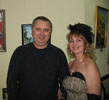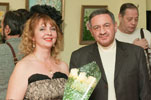 A descendant of Ludovich XIV commissioned a portrait of his mother and father to the Russian painter.
A descendant of Ludovich XIV commissioned a portrait of his mother and father to the Russian painter.
The nobility of Monaco and France in the towns Nice, Cannes, Monaco, St.Paule Lavance, Antibes and Monte-Carlo were charmed with the pictures by a Russian painter from Pokrovsk. In the above towns she exhibits her works more frequently than in her native Saratov Region.
At the opening of Alfia PonomarenkoĎs exhibition in Monte-Carlo the titled persons couldnít imagine that many years before that astonishingly beautiful woman-painter from a provincial town on the Volga had been painting 3 metres high portraits of the Political Bureau membersÖ. After the opening ceremony Count Maurice de LíArbre commissioned the portraits of his parents to the Russian painter. Five years later Alfia would say: ďAt that moment I didnít know that he was a descendant of King Ludovich XIV in motherís line, otherwise I would have been very nervous and excited! When I brought the completed portraits the Count highly appreciated my work and asked me to add the family coat-of-arms in the corner of both portraitsĒ.
 As for me (a journalist), I took great interest in the painterís life story. I wondered why she preferred overseas to the native region.
As for me (a journalist), I took great interest in the painterís life story. I wondered why she preferred overseas to the native region.
The road to Nice.
ďTen years ago, turning the pages of the photo-album with my pictures, my fried Svetlana from Nice said:Ē Why live here? Why not go to Nice with me? Iíve got a friend there who works for a well-to-do Frenchman. He is an organizer of art exhibitions and owns restaurants and vineyardsĒ. Frankly speaking, this idea came to my mind not once. I understood that I must move forward andÖ I borrowed money for the trip to Nice. It was 2002. In Nice, selecting pictures for the exhibition, the organizers took pictures for photos. I explained these were pictures, not photos. They were greatly surprised and took a decision to organize my exhibition without delay despite the big number of painters waiting for their turn to exhibit. After a very successful start the chief artist of Southern France, Chairman of the Local Artistic Association said to me:Ē You should stay here and paint portraits!Ē. I had to reject that proposal for my son was finishing his 9th grade at school. My refusal surprised the Frenchman for in Europe career is above family. As for the French, they do not put much effort in bringing up children.
The portrait of His Highness.
 ďPrinces have no time to seat for a portrait. Add to this that I like to paint at night. Long ago there were court painters. Why were they called so? Because they lived and painted at the court. Nowadays this is impossible. In 2004 I painted the portrait of Prince of Monaco Ė Renier III. When the Prince saw the completed portrait he took it and carried it to his castle. The guards tried to help him but the Prince said:Ē No, I want to carry this portrait myselfĒ. It was very pleasing for me. The portrait was really very close to the original.
In a couple of years at the personal exhibition in Monte-Carlo I met Honorary Consul of Russia Claude Palanka. The presents from Russia - a chrystal sterling, the symbol of Saratov Region, and the portrait of His Highness Prince Albert II - appealed to him. That ďcomplicatedĒ portrait moved to the family castle on the national holiday of Monaco. Why ďcomplicated?Ē I am sure that a real artist should paint portraits not for commissioners but for descendants. A painter must know many details in the life and character of the person to be painted. To paint a realistic portrait means to reveal the inner world of the model. For this you should drink tea together and chat for a while to get a better inner look at the future model, and this cannot be done with a photo camera. I have spoilt completely the first variant of the portrait. In despair I called to Monaco and asked the people from his close environment to tell about their Prince as much as possible. In answer I heard:Ē Oh, the Prince likes to court beautiful women ÖĒ. At once I understood what was embarrassing me: on the photo one Albertís eye was looking straight but the second eye was slipping away. His face could be conventionally divided into two parts: if you close one part of the face the Prince looks very serious as Head of the richest country should look. And on the other part the corner of the lip was smiling. That was the look of real Kasanova. When this idea struck me I took the brush and quickly completed the portrait.Ē
ďPrinces have no time to seat for a portrait. Add to this that I like to paint at night. Long ago there were court painters. Why were they called so? Because they lived and painted at the court. Nowadays this is impossible. In 2004 I painted the portrait of Prince of Monaco Ė Renier III. When the Prince saw the completed portrait he took it and carried it to his castle. The guards tried to help him but the Prince said:Ē No, I want to carry this portrait myselfĒ. It was very pleasing for me. The portrait was really very close to the original.
In a couple of years at the personal exhibition in Monte-Carlo I met Honorary Consul of Russia Claude Palanka. The presents from Russia - a chrystal sterling, the symbol of Saratov Region, and the portrait of His Highness Prince Albert II - appealed to him. That ďcomplicatedĒ portrait moved to the family castle on the national holiday of Monaco. Why ďcomplicated?Ē I am sure that a real artist should paint portraits not for commissioners but for descendants. A painter must know many details in the life and character of the person to be painted. To paint a realistic portrait means to reveal the inner world of the model. For this you should drink tea together and chat for a while to get a better inner look at the future model, and this cannot be done with a photo camera. I have spoilt completely the first variant of the portrait. In despair I called to Monaco and asked the people from his close environment to tell about their Prince as much as possible. In answer I heard:Ē Oh, the Prince likes to court beautiful women ÖĒ. At once I understood what was embarrassing me: on the photo one Albertís eye was looking straight but the second eye was slipping away. His face could be conventionally divided into two parts: if you close one part of the face the Prince looks very serious as Head of the richest country should look. And on the other part the corner of the lip was smiling. That was the look of real Kasanova. When this idea struck me I took the brush and quickly completed the portrait.Ē
First, you should fall in love with the General.
ďMy teacher Victoria Shkunova used to say: ďAll faces are interestingĒ. To paint a good portrait you should fall in love with your model. And you should grasp and keep this moment of love and bring it to the portrait. Sometimes itís not easy, for some models donít arise sympathy. Once I was painting a General from Moscow. Many times I opened and closed my album for sketches and couldnít start painting. For two weeks I had been trying to fall in love with the General. ďHe is a good father of the family, he loves children, tolerates his mother-in-lawÖĒ I persuaded myself. And at last I caught the moment of love to that man and rushed to the canvas. The portrait was a success though it was life-size. One more memoryÖ I was finishing the portrait of a high official and one day that very person spoke very rudely to me over the telephone. I got offended and couldnít take to work for a long time: a painter mustnít splash his bad mood on the canvas. When I am in low spirits or absolutely exhausted with work my husband takes me to the forest to get strength and balanceĒ.
Gorbatchev without a single spot.
ďI am crazy about painting. I have had a nice schooling at the Arts Workshops at the Union of Russian Painters. The process was as follows: from Moscow we were brought the photos of the Party leaders. Black-and- white photo of Gorbatchev was sent to us without the birthmark. The birthmark was not desired and it had to be retouched. My partner Nina Denisova and I attached a huge canvas, put a table, a chair on the table, made some touches then went down to glance at the portrait from the distance and again climbed up. Luckily, we were twenty, worked fast and had a wonderful teacher nearby Ė uncle Eugeny (a teacher at the Arts Fund Ė Eugeny Gelnov). ďAdd some red colour here and some green colour thereĒ, he taught us. I keep sweet memories of my teacher at Arts School named after Bogolubov Ė Stanislav Taratukhin (a school principal now). He used to put me lots of bad grades for drawing and sometimes disbehaviour. As a result I had to work hard all summer under my motherís watching eye while my groupmates enjoyed holidays. In 1997 at one of my exhibitions Stanislav Konstantinovitch, having looked at my pictures, said that the result of those bad grades was obvious.
Today itís impossible to tear me off the canvas. I can paint sixteen hours a day. Rare outings to the nature help me to relax. A friend of mine lives in Teplovka, a small, wonderfully beautiful place where I like to come. There I wash off the paints and fish for crucians.
You ask me what I am painting for pleasure? Flowers at my summer cottage, and every time I paint them differently. My mum recently said:Ē You have learned to paint flowers at last!Ē Today I am dreaming to paint a ceremonial portrait of a luxurious woman in the interior. Katrene Deneuve, for example.Ē

